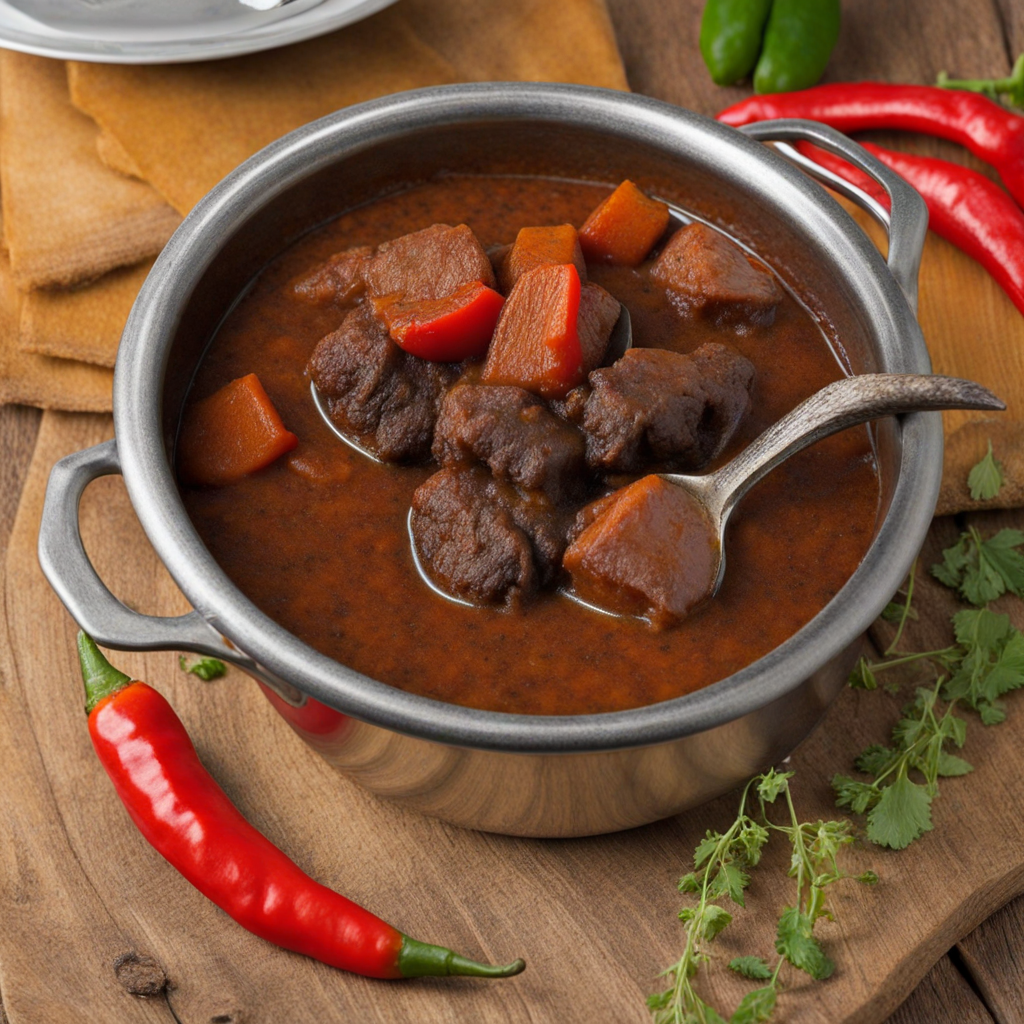Pepperpot
Pepperpot is a richly spiced and hearty stew that embodies the essence of Guyanese cuisine, offering a unique blend of flavors that tell the story of its cultural heritage. This dish is traditionally made with beef, though variations can include pork or even chicken, simmered slowly to achieve a tender and succulent texture. The meat is infused with a medley of spices such as cinnamon, cloves, and hot peppers, creating a warm and aromatic profile that is both comforting and invigorating. What truly sets Pepperpot apart is the use of cassareep, a thick, dark sauce made from the cassava root, which not only lends a distinct sweetness but also enhances the stew's complex flavor with its rich, earthy undertones.
How It Became This Dish
The History of Pepperpot: A Culinary Treasure of Guyana #### Origins Pepperpot is a rich, spicy stew that has become synonymous with Guyanese cuisine, encapsulating the country’s diverse cultural heritage. Its roots can be traced back to the indigenous peoples of the region, who utilized local ingredients to create hearty dishes. The Arawaks and Caribs, the original inhabitants of Guyana, relied heavily on the natural bounty of the land, incorporating cassava, fish, and game into their diets. They had a deep understanding of spices and herbs, which laid the groundwork for the flavorful dishes that would emerge later. With the arrival of European colonizers in the 16th and 17th centuries, particularly the Dutch and the British, the culinary landscape of Guyana began to transform. These colonizers brought with them various spices, including black pepper, which would become a defining characteristic of Pepperpot. Moreover, the introduction of enslaved Africans brought new cooking techniques and ingredients to the mix, resulting in a fusion of culinary traditions. #### Cultural Significance Pepperpot is not just a dish; it is a symbol of Guyana's cultural identity. Traditionally, it is served during special occasions, especially Christmas and other festive gatherings. The preparation of Pepperpot is often a communal activity, where family and friends gather to cook and celebrate together. This practice reinforces familial bonds and cultural ties, showcasing the importance of food in bringing people together. The stew is also emblematic of resilience and resourcefulness. Historically, Pepperpot was a practical dish that could be made in large quantities and preserved over time. The use of cassareep, a thick sauce made from cassava, allows the dish to last for several days without spoiling, making it an ideal meal for the days leading up to Christmas when households would often be busy with other preparations. The necessity for preservation speaks to the ingenuity of the Guyanese people, who learned to adapt their cooking methods and ingredients to the available resources. #### Development Over Time As Guyana's history unfolded through colonization, slavery, and migration, the Pepperpot recipe evolved, incorporating new influences. The British Empire's presence led to the introduction of spices such as cloves, cinnamon, and allspice, which enhanced the depth of flavor in the dish. Meanwhile, the African influence brought in techniques like slow cooking and the use of meats, particularly beef or pork, which are commonly used in modern Pepperpot recipes. The significance of Pepperpot transcends its culinary identity; it serves as a historical narrative of the people who have shaped Guyana. The dish reflects the amalgamation of cultures—indigenous, European, African, and, more recently, East Indian and Chinese—each leaving an indelible mark on the recipe and its preparation. In the 19th century, as indentured laborers from India arrived in Guyana, they contributed their own spices and cooking techniques, further diversifying the culinary landscape. In contemporary times, Pepperpot remains a staple in Guyanese households. It is often served with bread or rice, allowing the rich sauce to be fully enjoyed. The dish is celebrated not only for its taste but also for its historical significance, often featured at festivals and national celebrations. In 2021, Pepperpot was even recognized as an essential part of Guyana's cultural heritage and was included in discussions about national identity. #### The Recipe and Regional Variations While the core of Pepperpot remains constant—a hearty meat stew flavored with spices—regional variations do exist. Some families may add a touch of ginger or hot pepper for additional heat, while others may incorporate different types of meat, such as goat or venison, depending on availability. The use of cassareep, a unique ingredient derived from the fermentation of cassava, is almost universal, providing the dish with its distinctive dark color and sweet, smoky flavor. The preparation of Pepperpot is often a labor of love, requiring patience and care. Traditionally, it is slow-cooked over a low flame, allowing the flavors to meld beautifully. The dish is typically prepared in large quantities, as it is meant to be shared and enjoyed over several days. The communal aspect of its preparation and consumption reinforces the notion of family and kinship, making Pepperpot more than just a meal; it is a cultural event. #### Modern Interpretations and Global Recognition In recent years, the global interest in diverse cuisines has brought Pepperpot into the spotlight. Guyanese immigrants have introduced this beloved dish to new audiences, hosting cultural events and food fairs that showcase its unique flavor profile. Chefs around the world have begun to experiment with Pepperpot, incorporating it into fusion dishes or presenting it in innovative ways while staying true to its roots. As globalization continues to influence culinary traditions, Pepperpot stands as a testament to the resilience and adaptability of Guyanese culture. It embodies the spirit of a nation that has faced challenges but has thrived through the sharing of stories, flavors, and traditions. The dish has become a symbol of pride for Guyanese people, whether they reside at home or abroad, serving as a reminder of their heritage and the rich tapestry of cultures that define their history. #### Conclusion From its indigenous roots to its modern interpretations, Pepperpot is more than a dish; it is a reflection of Guyana's history, culture, and the indomitable spirit of its people. As it continues to evolve and adapt, Pepperpot remains a cherished culinary emblem, inviting all who taste it to partake in the rich stories and traditions that it carries. Whether enjoyed during festive celebrations or as a comforting meal at home, Pepperpot is a dish that brings people together, celebrating the vibrant mosaic of flavors that is Guyanese cuisine. With each spoonful, one not only savors the complexity of its spices but also the enduring legacy of a culture that thrives on unity, resilience, and the power of food.
You may like
Discover local flavors from Guyana







